Home » Hunting Dogs » How Wind Affects Birds and Hunting Dogs
How Wind Affects Birds and Hunting Dogs
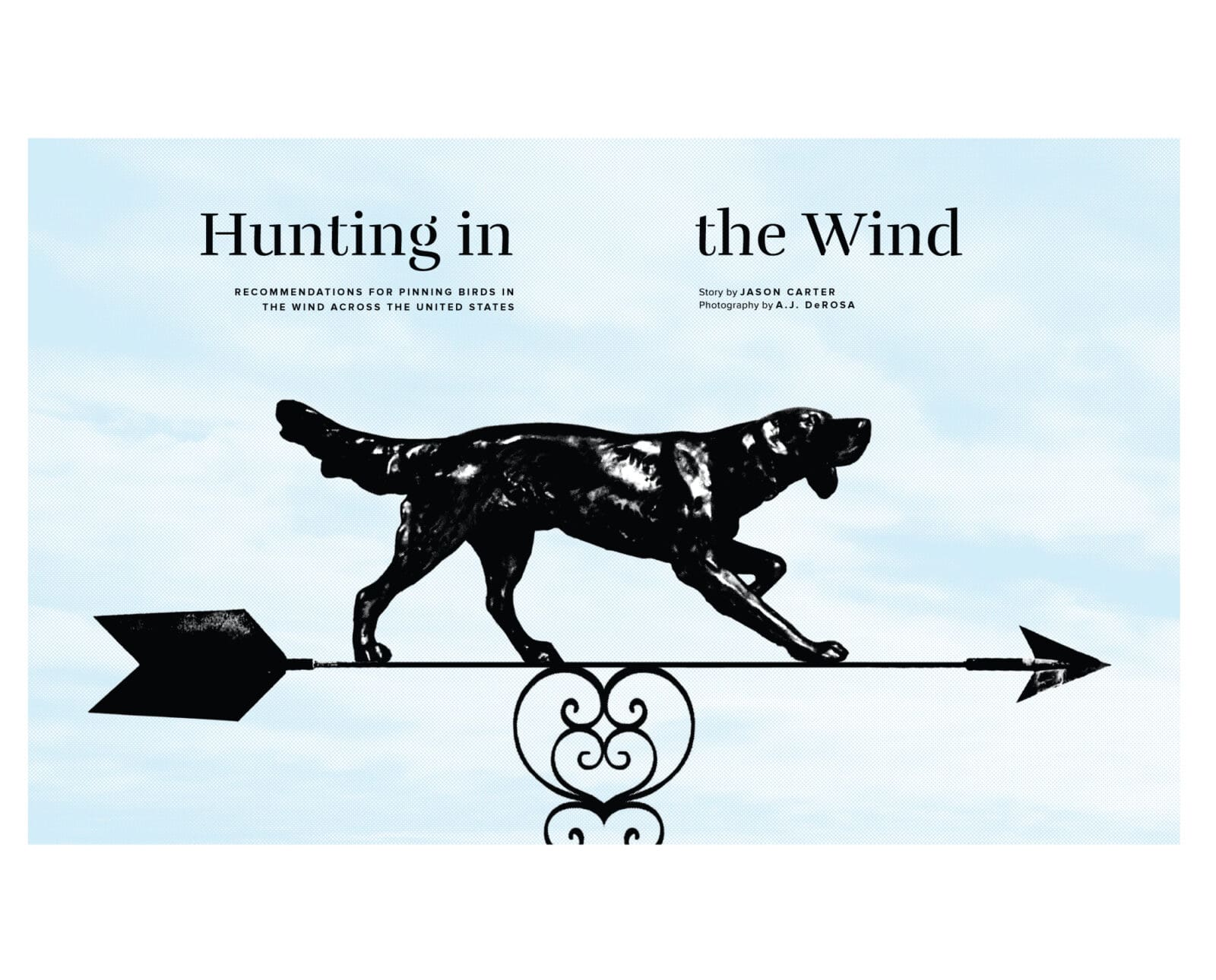
Jason Carter is a NAVHDA judge, NADKC member, director of…
Recommendations for pinning birds in the wind across the United States
As I set up on another flock of turkeys one blustery spring day, I felt somewhat beaten down by how unresponsive and skittish the birds had become. I could see turkey heads nervously popping up and down while they fed toward my decoys. As each group approached, they found something they didn’t like and would begin to do what I call “The Jerky Turkey,” nervously pacing back and forth before running off.
Listen to more articles on Apple | Google | Spotify | Audible
I felt like I was being picked apart. I know the weather affects bird behavior, though it hit me that day how much wind and hearing loss puts birds on high alert. A bird’s survival instincts depend heavily on hearing, so much so that if that sense is diminished on a windy day, the birds become incredibly nervous and quick to run or take flight at the first sign of trouble. This is something we should consider when upland hunting.
Being raised by two bird-hunting-obsessed parents, the thought of not hunting due to poor weather conditions never gets serious consideration. Hunting season comes and goes in a blink of an eye; missing a day of hunting feels like memories blowing away in the wind. Knowing how to hunt successfully in inclement weather is essential to the upland experience.
The wind significantly impacts hunters, hunting dogs, and birds when upland hunting. It can bottom out the thermometer, blow sand in our eyes, cut through clothing like a knife, and force us to adjust our hunting plans and dog tactics. In talking to various avid bird hunters across the United States, I found many similarities in hunting tactics and a handful of differences between game species and hunting regions when it comes to hunting in the wind.
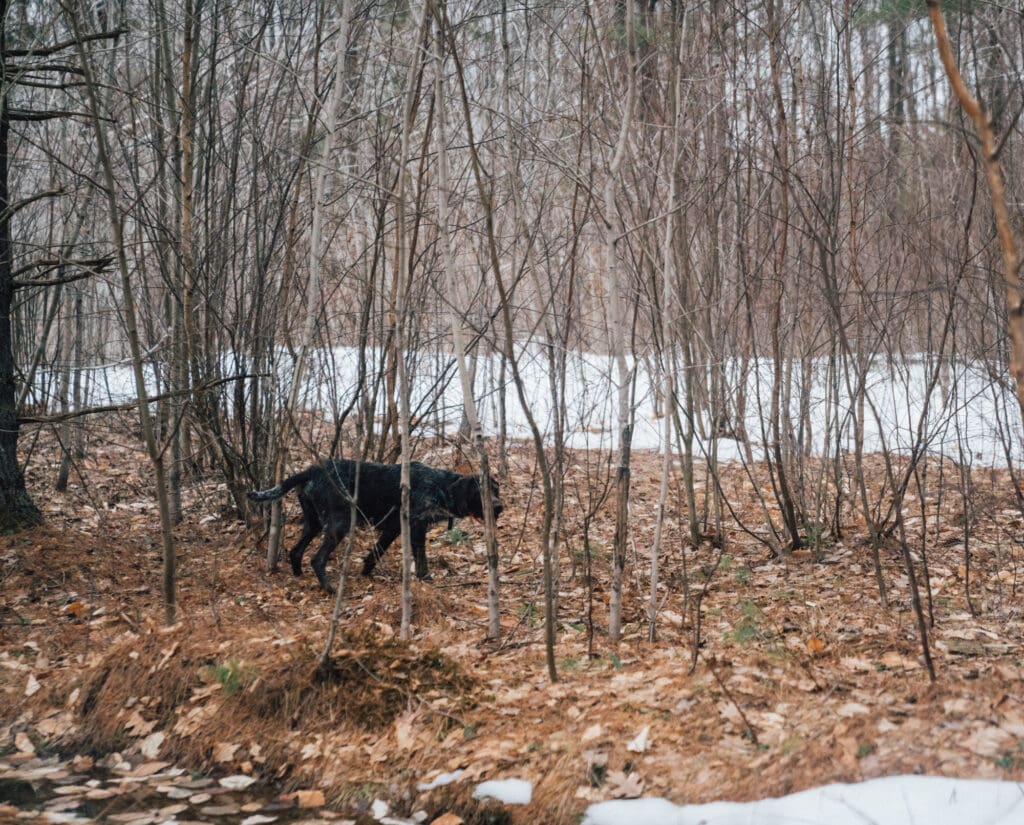
Hunting the Wind in the Northeast
Andy Weik is an upland hunting guide, a consulting forest wildlife biologist in New York, and a former northeast RGS biologist. He believes the wind makes scenting birds more difficult for the dog due to making the birds nervous and “flighty.” Weik explains:
“The wind makes it hard for me to hear my dog’s bell. Also, a strong and variable wind blows apart the bird’s scent cone, making it harder for the dog to pinpoint and handle the bird. To visualize the scent, think of what a gusty wind does to wood smoke versus what a light breeze does to it.
“In the woods, I am constantly aware of the wind. It’s more difficult for a dog to work with the wind at its back, and though I try to avoid hunting with the wind, sometimes it’s unavoidable. Every time I walk in on my pointing dog, I note the wind direction relative to the dog for clues as to the location of birds.”
Wiek prefers to hunt on a crosswind when possible. Crosswinds provide equal opportunities for Andy to maximize scenting opportunities for his dog on the way out and back from his truck.
Additionally, when hunting woodcock, the wind and weather play a big role in predicting migrations into your local covers. Weik continued:
“Weather systems affect woodcock migration. In particular, I look at the forecast for cold fronts and centers of high pressure forming to the north. A cold front forms when a mass of cold air moves into and displaces a mass of warmer air. What comes behind the cold front is a high-pressure system, with winds blowing clockwise around the center. During fall, I’m looking for centers of high pressure to the northwest to bring me more flight birds.
“If the woodcock’s biological clock tells the birds it’s time to go, the dropping barometer will kick them into action to head south. Before that time, heavy winds will force these little birds to retreat towards the lee side of hills and mountains or into a protective cover such as planted pines.
“Warm weather can be a problem for the grouse hunter early in the season. With warm temperatures come poor scenting conditions. Additionally, grouse often seek shady areas with a cooling breeze. They will spend the day perched high overhead in spruce or other conifer stands. Hunting early and late with a lengthy midday siesta is the best one can do on warm days. Or go fishing.
“The ruffed grouse is also heavily impacted by the wind. They become very skittish in the wind, making them extremely difficult to pin. The survival instincts of the ruffed grouse are legendary. On windy days it becomes exponentially more difficult to see one flush and even harder to hear. However, a gentle breeze of five to eight miles per hour can make for an epic day. It pushes the scent out to a range where it triggers the point yet allows the bird to comfortably set up without taking flight.”
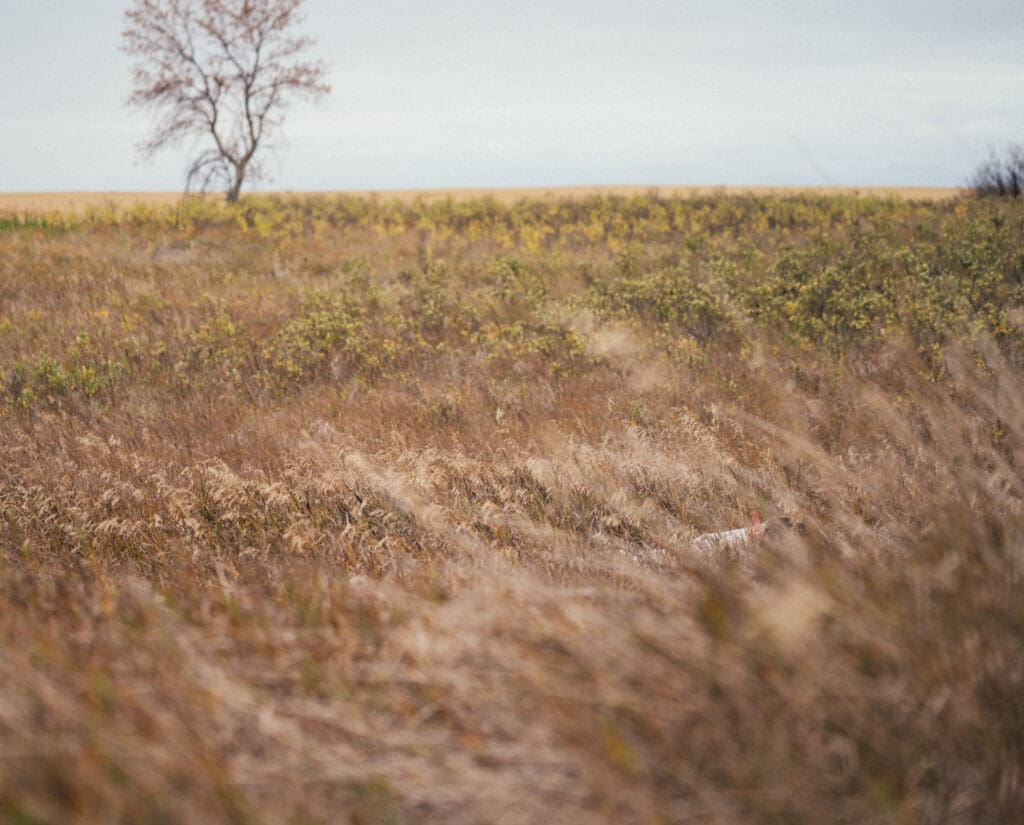
Hunting the Wind in the West
Popular podcast personality Ron Boehme of The Hunting Dog Podcast shares his hunting strategies when dealing with windy days in the field. Ron believes his stomping grounds of South Dakota could be the windiest state in the lower forty-eight. About hunting in the wind in western states, Boehme said:
“While hunting in South Dakota for the last three decades, the wind has taught me many things about bird hunting. We can all agree that days with gentle winds benefit the dogs and the birds. Birds have an incredible advantage in low wind conditions because of their hearing. Every noise we make, from our feet and our dog’s, can be amplified and sent across at ground level like a loudspeaker. Of course, we would always like to hunt our dogs into the wind, but that would mean on every walk, we would have a vehicle waiting for us at the other end.
“When approaching a section of land, it is common practice to hunt with a crosswind. Each trip up and down the field somewhat levels the playing field when it comes to alerting the birds while giving the dogs some scenting advantage. Dogs that have spent several seasons hunting in windy places learn to use that to their advantage when it comes to how they cast in the field.
“But we should talk about truly windy days. The days when you find yourself squinting and wiping the dirt from both your and your dog’s eyes can be a real challenge. Sometimes an entire trip could fall into this weather. Again, the disadvantages pop up in different categories. With a strong enough wind, even the terrain of grass and bushes begin to make noise that can confuse a bird’s hearing. Instinctually birds are going to move less and hunker down. Or if the area has low spots like ravines or drainages, the birds may be going there to feel more comfortable.
“When hunting hilly areas for birds like sharptails, one would always hunt the leeward side of a ridgeline; that means our approach has to be different. We may have to walk with the wind at our back, so we crest those hills in an almost jump-shooting fashion. I hunt slower on days like that, giving the dog more opportunities to sort things out and pursue objective areas.
“The Dakotas are full of wind-breaking tree lines that the farmers put in decades ago to protect crops fields from wind erosion. Even regular fence lines usually have thicker covers than the fields they surround. On very windy days, I only spend a little time in the center of any section of land. Of course, walking all four sides of a square field means you will have the wind working against you on at least two sides. And that is where teaching your dog to adjust its range and pattern is valuable. Quite honestly, it doesn’t take long for a dog to realize that good things may happen if he runs along the fence line. And don’t worry: on those bluebird days with a light breeze, you can let him have his head and range out into the big fields where the birds are back to their usual habits of roosting and feeding and loafing.”
Darin Tolzin, a Nebraska native who has spent most of his life hunting prairie grouse and chickens, bobwhite quail, and pheasants, believes wind has a major effect on bird location and behavior. Tolzin explains that “it’s more the combination of wind and temperature that has the largest factor in altering how the birds travel and their reactions to hunting pressure.” He goes on to say:
“First, any day in the field is better than a day in the recliner. On windy days, I work the ridges and run my dogs on the lee side of the hills, switchbacks, coulees, and into draws. If hunting with a friend, they may walk an opposing ridgeline or block the end of a draw to get in range of escaping birds, though it’s really about the handler’s skill and their dog’s ability to pin birds. Prairie grouse can be tough to point on windy days because getting them to set up is hard. They get up early, and when it gets cold and windy, they tend to group up, sometimes in groups of over two hundred birds. That’s a lot of eyes looking at you. Typically, winds exceeding twenty miles per hour make hunting prairie grouse difficult. It takes an exceptional dog with the right traits and the right dog training to pin prairie grouse consistently. I’ve seen ruffed grouse and woodcock dogs come here and struggle to handle our birds. It was as if the dogs had never pointed a bird.”
Tolzin explained to me that birds generally use the wind to their advantage, helping to accelerate their getaway. This can make shooting very challenging in the wind. Though many folks play around with loads and shotgun chokes, he believes only one percent of shooters have the knowledge and skill to make gun modifications advantageous to their shooting.
“Quail set up tight in the wind and cold. Like us, they don’t like moving when it’s cold out. They go into survival mode and conserve energy. When I locate a covey, it gets entered in my OnX Hunt app, and I can later find them coveyed back up within a couple hundred yards of that pin. Prairie grouse, on the other hand, are far more sporting to hunt than the ‘bobs,’” Tolzin explained. He finds that the prairie grouse can challenge even the best of hunters. Given their superior survival instincts, prairie grouse tend to be masterful escape artists.
“When it comes to pheasants, they simply don’t play by the rules. They are very unpredictable. I do find that they will sit tighter on cold or snowy days than on windy days. Wind makes them nervous because of the moving grass and their inability to hear an approaching predator. Pheasants tend to make their way into roadside ditches and draws to escape the wind, though you just never know.”
Many folks work pheasants as a team, lining up to force march birds into the air in a driven pheasant hunt fashion. However, Tolzin prefers to work with his dog either alone or with one other friend. He feels it allows him time to focus more on his dog, appreciating their partnership. “It’s about the dog and the enjoyment I get seeing it pin birds,” he said.
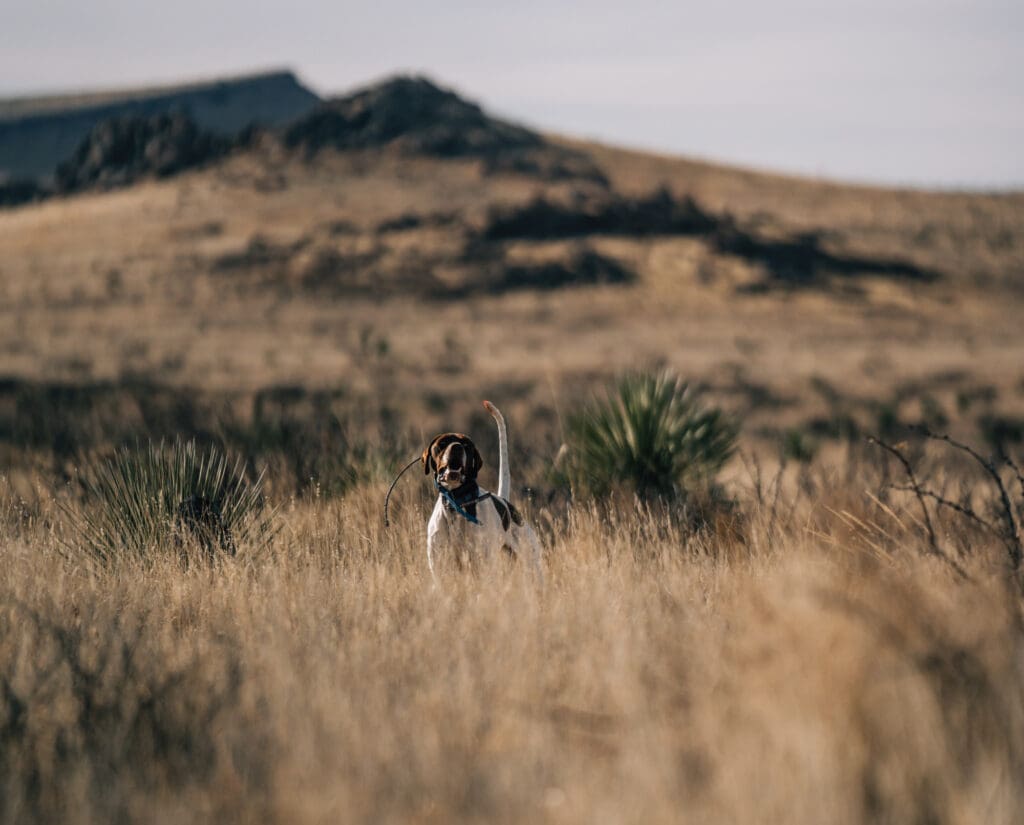
Hunting the Wind in the Southwest
Ray Trejo, a southwest New Mexico resident who works for the New Mexico Wildlife Federation and a is contributing writer for various upland hunting magazines, shared:
“Personally, I love to hunt in the wind and encourage others to do the same. Quail will act differently on windy days, which I use to my advantage. The fleet-footed Gambel’s and scaled quail will hold much better in the wind, giving the dogs a better pointing opportunity and more action for the upland hunter during these windy weather conditions.
“When it comes to shooting, I can almost without a doubt know that the birds will use the wind to escape; with that said, it allows me the advantage to position hunters for the flush.
“I am very privileged and proud to live in New Mexico because of its abundance of public lands, which has allowed me and my family to hunt.”
Knowing how to handle the wind and taking advantage of the opportunities it provides can dramatically improve the success of a hunt. It can be a rewarding experience if you know how to prepare and adjust. The challenges of a difficult pursuit foster a deeper understanding and respect for the game we hunt.
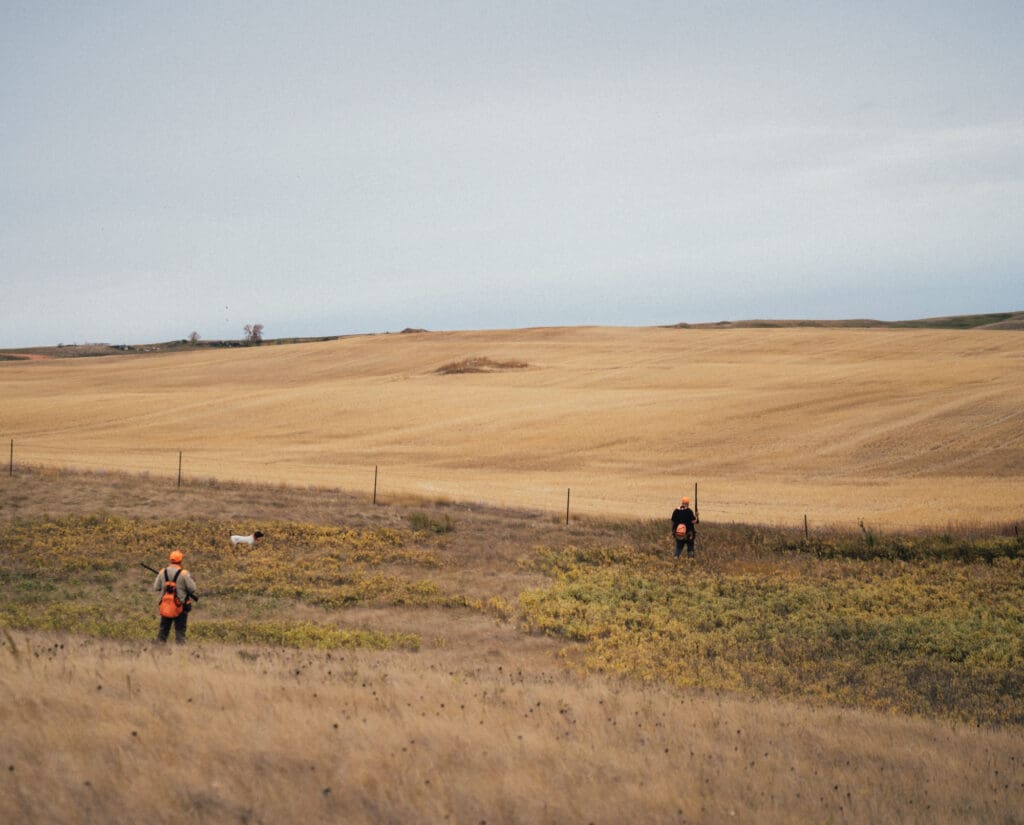
Using the Wind while Bird Hunting
Upland hunting, for me, is as much about enjoying the outdoors as it is about hunting. For this reason, I tend to hunt very quietly, speaking to my dogs only as much as necessary. I don’t run a bell for the most part, though I will on windy days to keep better tabs on them.
Being from the northeast, wind storms can drive birds away from primary feeding areas towards more protected grounds such as conifers. Both woodcock and grouse rely heavily on conifers for their survival. On windy days, woodcock tend to tuck themselves under planted pines or protective thickets. They also are more inclined to run before taking flight, whereas grouse are quick to take flight, retreating to the security of the treetops at the first sign of trouble. Due to the dense covers we hunt, we depend on hearing wing beats to gain directionality on escaping birds. Wind can make this very difficult, particularly in the early season when the leaves are still clinging to their branches.
It’s common to underutilize the wind when upland hunting. Terrain, habitat, and convenience are greater influences on how we navigate the hunt. Many folks enjoy the freedom of drifting off across a landscape, letting the dogs, birds, and cover dictate their destination. However, keeping the dogs on the right side of the wind will grant you more shooting opportunities.
Something to pay close attention to is how your dog is working the wind. Oftentimes, just because the wind is blowing in our faces doesn’t mean it’s blowing the same way on the ground. Think of scent traveling like a river. When it hits obstacles, it eddies up behind it, pooling the bird scent in that area. That’s the reason your dog sometimes loses accuracy, causing it to point in one direction while the bird flies in another. A better indicator of air currents is observing vegetation closer to the dog’s level.
If you watch an experienced bird dog closely, you’ll notice the dog adjusts its speed and hunting patterns depending on where scent is on the wind. Once the dog places itself on the right wind, its behavior changes, and you’ll see it cast its nose up into the wind, dissecting every molecule in search of bird scent.
When you see the dog doing this, don’t call it off its job. Let it work. Become a master at using the wind to locate and pin birds for you. Too often, we get caught up in manually casting our dogs that we deny the dog the ability to refine its nose work, which causes it to bump or overrun birds. The dog that feels comfortable following its nose masters how to handle birds and enriches your time in the field.
As upland hunters, we spend months preparing our dogs, researching and acquiring land access, studying the latest nesting reports, and honing our shooting skills. We hope to gain an edge that provides a few more opportunities to see our dogs work and, if the fates allow, the harvest of a special game bird. There is something primal and self-fulfilling when overcoming the elements. It’s more than another page in your journal; it’s a memory you’ll look back with a smile and say, “Remember that amazing time we had hunting in all that wind?”
Jason Carter is a NAVHDA judge, NADKC member, director of youth development, secretary of NAVHDA’s youth committee, clinic leader and trainer at Merrymeeting Kennels. He has been around versatile hunting dogs his entire life, literally! Born into the Carter family and Merrymeeting Kennels, he attended his first NAVHDA test in Bowdoinham, Maine, when he was just a year of age. Jason successfully trains, tests and breeds Deutsch Kurzhaars in both the NAVHDA and NADKC testing systems. Through his work at the kennel, Jason has had the opportunity to develop pointers, flushers and retrievers over the years. When October arrives he can be found with family and friends hunting throughout New England.




Isn’t Ron Boehme the guy with those dock tailed bloodhound looking dogs? From that meateater episode I doubt Ron’s dog could locate a country ham on a tailgate